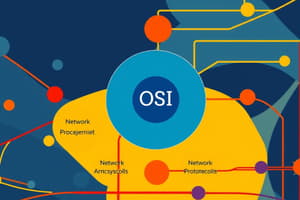Podcast
Questions and Answers
Physical topology refers to how software controls access to network resources.
Physical topology refers to how software controls access to network resources.
False (B)
Logical topology includes how users and software initially gain access to the network.
Logical topology includes how users and software initially gain access to the network.
True (A)
A network operating system (NOS) is not required by client-server models.
A network operating system (NOS) is not required by client-server models.
False (B)
In a peer-to-peer (P2P) network model, there is centralized control.
In a peer-to-peer (P2P) network model, there is centralized control.
Peer-to-peer network models are scalable.
Peer-to-peer network models are scalable.
Peer-to-peer network models are practical for large installations.
Peer-to-peer network models are practical for large installations.
Network and computer technicians need to know how to protect themselves but do not need to protect sensitive electronic components.
Network and computer technicians need to know how to protect themselves but do not need to protect sensitive electronic components.
The best escape route or emergency exit should not be known by individuals in case of an emergency.
The best escape route or emergency exit should not be known by individuals in case of an emergency.
The fire suppression system in the data center should include an emergency alert system and portable fire extinguishers.
The fire suppression system in the data center should include an emergency alert system and portable fire extinguishers.
An SDS (safety data sheet) provides information on handling chemical solvents but does not include first-aid measures.
An SDS (safety data sheet) provides information on handling chemical solvents but does not include first-aid measures.
The security system allows access during a failure (fail open) but does not deny access during the failure (fail close).
The security system allows access during a failure (fail open) but does not deny access during the failure (fail close).
Network and computer technicians do not need to pay attention to physical and chemical properties of substances.
Network and computer technicians do not need to pay attention to physical and chemical properties of substances.
The safety procedures and policies can be scanned, copied, duplicated, or posted to a publicly accessible website.
The safety procedures and policies can be scanned, copied, duplicated, or posted to a publicly accessible website.
The copyright of the text belongs to Cengage and it may be freely copied or duplicated for commercial use.
The copyright of the text belongs to Cengage and it may be freely copied or duplicated for commercial use.
The application layer describes the interface between two applications on separate computers.
The application layer describes the interface between two applications on separate computers.
Layer 7 of the OSI model is responsible for reformatting, compressing, and encrypting data.
Layer 7 of the OSI model is responsible for reformatting, compressing, and encrypting data.
The payload refers to the data passed between applications or utility programs and the OS.
The payload refers to the data passed between applications or utility programs and the OS.
Layer 6 of the OSI model provides services to the user, such as a browser and web server.
Layer 6 of the OSI model provides services to the user, such as a browser and web server.
SNMP (Simple Network Management Protocol) programs that monitor and gather information about network traffic are categorized under Layer 7 protocols.
SNMP (Simple Network Management Protocol) programs that monitor and gather information about network traffic are categorized under Layer 7 protocols.
The presentation layer is responsible for the application-to-application communication and end-to-end connections.
The presentation layer is responsible for the application-to-application communication and end-to-end connections.
Flashcards are hidden until you start studying




